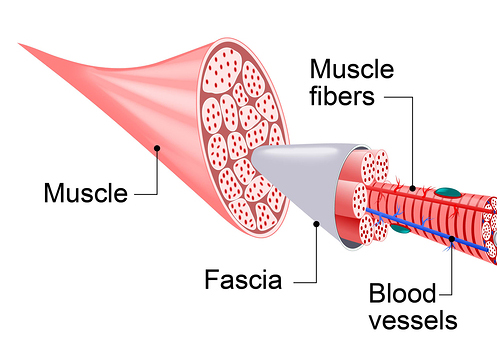Fascial Tissue and Why It’s Important
“What is fascial tissue and why is it important to work on?”
We’ve heard this question a lot. Fascial tissue is a multi-directional fibrous membrane that gives form and shape to muscles. It is found throughout the body from your head to your toes. It covers nerves, bones, abdominal contents, and blood vessels. Neat fact, it is even found in the brain! It functions to keep it contained and nestled safely within the cerebrospinal fluid (the fluid surrounding the brain and spinal cord).
Depending on your history and lifestyle, fascia is prone to the same tightness issues as muscles. Fascia has a nerve supply, just like the rest of the body, and can therefore be painful. Made up of multiple layers with fluid in between, it allows for smooth movement over body structures. Activity level, posture, nutrition, hydration, and past surgical or traumatic experience can cause the fascia to become restricted. This causes problems with range of motion (ROM), headaches, migraines, and digestive issues.

How do we alleviate the discomfort associated with fascial restrictions?
Many things can. Everything from simple exercises, stretching, drinking water, or changing food intake. Because it is a restriction, Massage Therapy is a valuable way of treating it. Your Massage Therapist will take a health history and perform assessments to ensure that the restrictions or pain are not coming from an underlying issue. At this point, they will then go over what they feel will be the best approach to your treatment.
Affected tissues are usually manipulated during treatment without lotion, and after the application of heat. This ensures the best “grab” of tissues and enables the therapist to move them using techniques such as:
- Skin rolling
- Direct and indirect techniques (directly on or close to the affected area)
- Deeper techniques
- Movement therapy (some may think of this as an Active Release Technique)
- Stretching
Some of these techniques are applied amid a regular massage session as well, depending on what the therapist has assessed and feels is best for your treatment.
What to expect at the end of the session?
After the session has finished, the therapist may send you home with home care. This may be as simple as drinking water. Or they may suggest stretches, exercises, yoga poses, and heat applications, as well as some techniques to try on yourself in between treatments. Be mindful of how you are responding to the treatment because this will give your therapist valuable feedback. Some short-term residual discomfort is normal. However, you should notice an increase in movement, and ease of breathing, and that pesky headache subsides or has gone completely. Sleep should be more comfortable and easier to obtain or maintain.
Like all modalities of treatment, it may not produce results immediately. Some areas may require a couple of treatments to be effective. Let your therapist know of all the after-effects of treatment. They may be able to modify future treatment approaches.
If you are ready to start looking at fascial release techniques, let your therapist know. They will try their best to answer any questions you may have. No question is a bad one, and they will want to ensure you have the best and current information to make an informed choice.
| Email us at admin@triadahealthottawa.com or book online. | |
| Learn more about our massage therapists. Alyssa Gregory, RMT Carly Smith, RMT Sarah Thexton, RMT Devin Brown, RMT |


